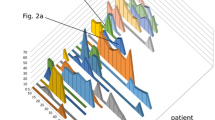Summary
Hemoglobin desaturation and arrhythmias have been reported during diagnostic gastroscopy and colonoscopy. During endoscopic placement of percutaneous gastrostomy tubes (PEG), the gastroscope is inserted twice and the stomach is markedly distended, thus increasing the potential risk of complications. Also, the procedure is frequently performed in patients exhibiting underlying systemic disease or little respiratory reserve. Patients undergoing PEG or percutaneous endoscopic jejunostomy (PEJ) were studied prospectively. Blood pressure, pulse, pulse oximetry, and lead II ECG tracings were obtained. Measurements were made before sedation, after sedation, at gastroscope insertion, at gastrostomy placement, at gastroscope reinsertion, and at 5 min after the procedure. In all, 50 patients (mean age, 56.8 years; 16 women, 26 men) underwent PEG only (39 cases) or PEG/PEJ (11 cases). The endoscopy suite was the site for the procedure in 38 cases and the intensive care unit was used in 12 cases. The mean time required for PEG and PEG/PEJ was 14.7± 1.1 and 18.9±2 min, respectively. Blood pressure remained stable throughout the procedure. Sinus tachycardia was observed in 72% of patients. Arterial oxygen saturation decreased after the administration of intravenous sedation but remained constant during the procedure. We reached the following conclusions: (1) desaturation occurs during sedation, (2) saturation remains constant during PEG/PEJ, (3) the mean blood pressure remains constant during PEG/PEJ, and (4) PEG/PEJ are safe procedures and monitoring should be individualized.
Similar content being viewed by others
References
Alexander CM, Teller LE, Gross JB (1989) Principles of pulse oximetry: theoretical and practical consideration. Anesth Analg 68: 368–376
A1-Hadeedi S, Leaper DJ (1991) Falls in hemoglobin saturation during ERCP and upper gastrointestinal endoscopy. World J Surg 15: 88–94
ASGE (1991) Monitoring of patients undergoing gastrointestinal endoscopic procedures: guidelines for clinical application. Gastrointest Endosc 37: 120–121
Bell GD, Spickett GP, Reeve PA, Morden A, Logan RFA (1987) Intravenous midazolam for upper gastrointestinal endoscopy: a study of 800 consecutive cases relating dose to age and sex of patient. Br J Clin Pharmacol 23: 241–243
Bell GD, Bown S, Morden A, Coady T, Logan RFA (1987) Prevention of hypoxaemia during upper-gastrointestinal endoscopy by means of oxygen via nasal cannulae. Lancet I: 1022–1024
Bough EW, Meyers S (1978) Cardiovascular responses to upper gastrointestinal endoscopy. Am J Gastroenterol 69: 655 - 661
Gauderer MWL, Ponsky JL, Izant RJ (1980) Gastrostomy without laparotomy: a percutaneous endoscopic technique. J Pediatr Surg 15: 872–875
Hayward SR, Sugawa C, Wilson RF (1989) Changes in oxygenation and pulse rate during endoscopy. Am Surg 55: 198–202
Levy N, Abinader E (1977) Continuous electrocardiographic monitoring with Holter electrocardiocorder throughout all stages of gastroscopy. Dig Dis 22: 1091 -1096
Lieberman DA, Wuerker CK, Katon RM (1985) Cardiopulmonary risk of esophagogastroduodenoscopy: role of endoscope diameter and systemic sedation. Gastroenterology 88: 468–472
Mathew PK, Ona FV, Damevski K, Wallace WA (1979) Arrhythmias during upper gastrointestinal endoscopy. Angiology 30: 834–840
Pecora AA, Chiesa JC, Alloy AM, Santoro J, Lazarus B (1984) The effect of upper gastrointestinal endoscopy on arterial O2 tension in smokers and nonsmokers with and without premedication. Gastrointest Endosc 30: 284–288
Ponsky JL, Gauderer MWL (1989) Percutaneous endoscopic gastrostomy: indications, limitations, techniques, and results. World JSurg 13: 165–170
Ponsky JL, Gauderer MWL, Stellato TA (1983) Percutaneous endoscopic gastrostomy: review of 150 cases. Arch Surg 118: 913–914
Reiertsen O, Skjoto J, Jacobsen CD, Rosseland AR (1987) Complications of fiberoptic gastrointestinal endoscopy - five years’ experience in a central hospital. Endoscopy 19: 1–6
Rostykus PS, McDonald GB, Albert RK (1980) Upper intestinal endoscopy induces hypoxemia in patients with obstructive pulmonary disease. Gastroenterology 78:488–491
Rozen P, Fireman Z, Gilat T (1982) The causes of hypoxemia in elderly patients during endoscopy. Gastrointest Endosc 28: 243–246
Silvis SE, Nebel O, Rogers G, Sugawa C, Mandelstam P (1976) Endoscopic complications: results of the 1974 (ASGE) survey. JAMA 235: 928–932
Author information
Authors and Affiliations
Rights and permissions
About this article
Cite this article
Morlote, E.B., Zweng, T.N. & Strodel, W.E. Hemodynamic monitoring and pulse oximetry during percutaneous gastrostomy and jejunostomy: necessity or nuisance?. Surg Endosc 5, 130–134 (1991). https://doi.org/10.1007/BF02653219
Issue Date:
DOI: https://doi.org/10.1007/BF02653219




